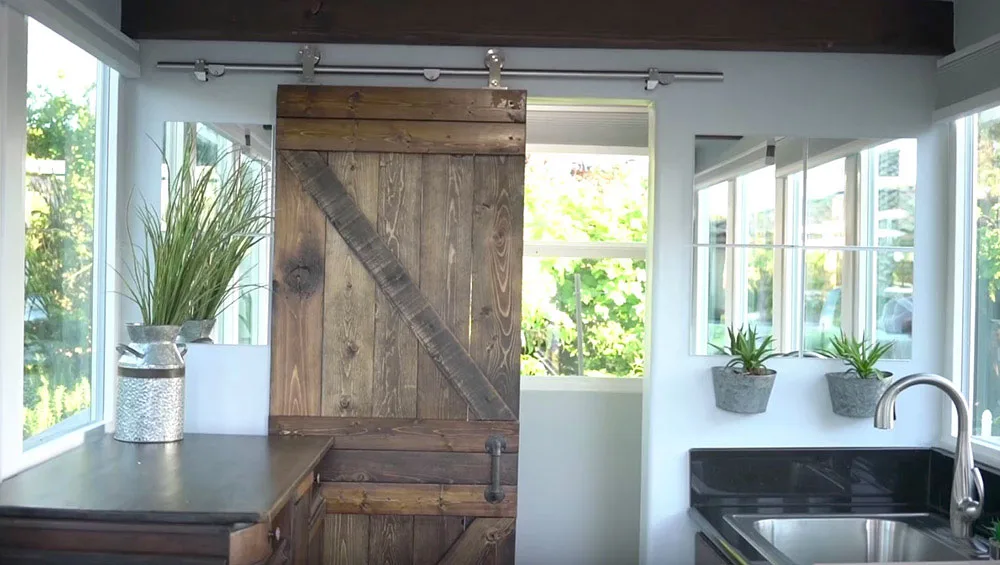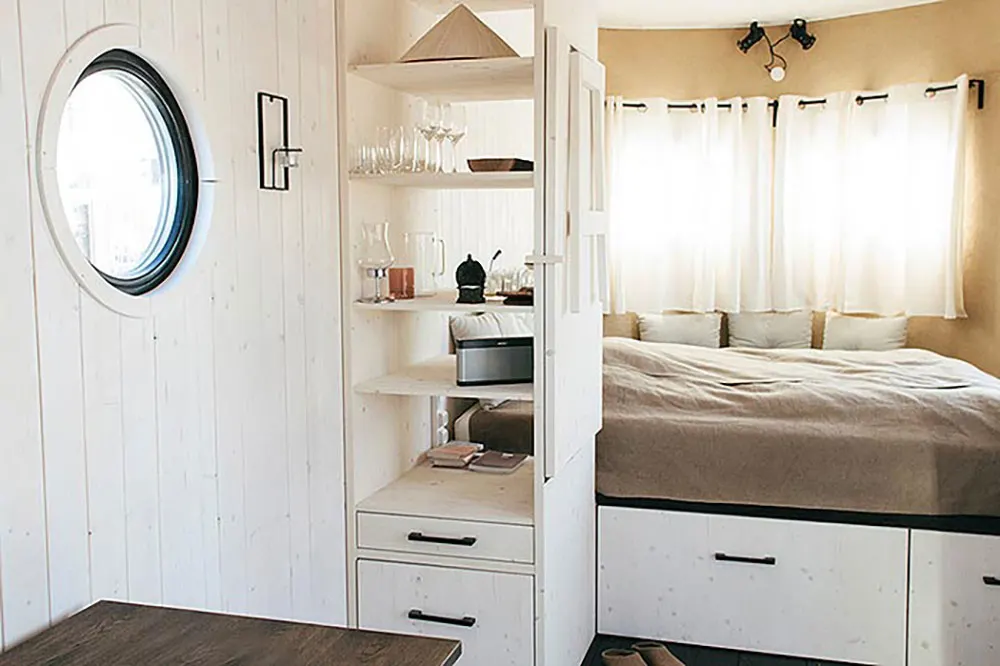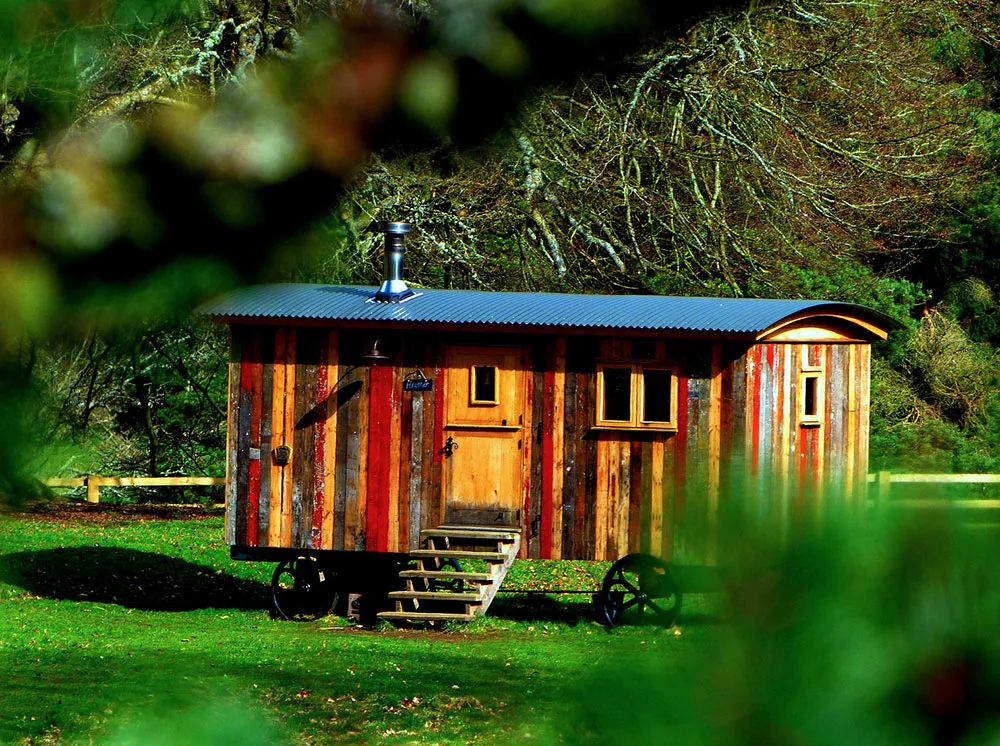Mobile cabins and other portable living spaces are the next big thing among people interested in a more luxurious kind of long-term travel and sustainable living off the grid. They offer you the ability to make your own RV or trailer that has everything you need to live, but designed to your style and needs.
Due to the smaller size and sustainable lifestyle mobile cabins attract, the main design principle to keep in mind is efficiency — efficient use of space, cost to build, and of energy use. Here are 5 design choices that help you make a more efficient mobile cabin.
#1 — Use Sliding Doors
First, let’s talk about the efficient use of the little space that your mobile cabin will have. In order to maximize the space inside your cabin, you should avoid using traditional doors that swing open and closed.
The problem is that when they’re open, they’re in the way of whatever furniture, shelves, or other things you might have on the floor or wall around the doorway. You don’t want to avoid using doors at all, as being able to close off parts of the cabin when you’re not using them helps maximize the efficiency of airflow for heating and cooling.
That’s why we recommend that you use sliding doors for every doorway inside the cabin. You can install them one of two ways. The first way is to leave a pocket space in the walls of the doorway that the door can slide into when you open it. The second way is to install the track on the outside of the wall, which does allow for some interesting-looking designs but also takes up space on the wall.

Interior sliding door on Alternative Living Spaces container home
#2 — Install Built-In Storage
Another big space-saver is by getting creative with your storage. Wherever you can, you can make efficient use of space by building storage into something else that already takes up room in the cabin. Emphasizing built-in storage helps you avoid having any cabinets or shelving sticking out from walls – the kind that can make the cabin space feel more cramped, and limit how much furniture is around to take up space.
The first way to do this is by building things like cabinets, drawers, and shelves into the interior walls of the cabin — avoid building shelves into any walls that face the exterior as you can create weak points in the insulation. The other is to buy furniture such as ottomans, couches, tables, beds, and others that come with storage built into them.
#3 — Invest in Insulation
Now let’s talk about energy use. When it comes to affordable and sustainable living, you want to limit the energy your cabin needs and uses as much as possible. The biggest expenditure of your energy is regulating the temperature of your home — more than half of an average home’s energy use comes from the furnace and air conditioning to heat and cool the interior. To reduce how much heat or cooling your cabin needs starting from the materials stage, make sure you don’t skimp on insulation.
Make sure you research eco-friendly insulation materials like recycled cotton and/or highly efficient materials such as polystyrene or aerogels. Also make sure you design your cabin to be fully insulated everywhere, such as the floors, walls, roof, and so on. Having a well-insulated home can reduce your energy consumption between 10% and 30% by preventing the constantly changing temperatures outside from affecting the interior of your mobile cabin as much.

Creative use of space inside Wohnwagon mobile tiny house
#4 — Use a High-Efficiency Propane Furnace
Another way to reduce energy use is by investing in a highly efficient furnace. Any furnace with an Annual Fuel Utilization Efficiency (AFUE) rating of 90% or higher is considered to be highly efficient by the U.S. Department of Energy. The most efficient furnaces you can buy are electric, but electricity also tends to be the most expensive source of energy for a furnace and not viable if you want to live more off the grid.
That’s why we recommend you design your mobile cabin to use a high-efficiency propane furnace. Propane furnaces can be highly efficient with AFUE ratings exceeding 95%, and as a source of fuel and energy can be more affordable and clean-burning compared to other fossil fuels.
For your mobile cabin, also make sure to design your air ducts and spaces to have efficient air flow in order to have more efficient heating. Avoid the extremely narrow ducts that traditional mobile homes use that can cause airflow problems.

#5 — Save Materials for Reuse
Lastly, when building your mobile cabin, you can be much more efficient with the cost and with its sustainability by recycling building materials for use. Look for materials such as recycled steel, wood, plastic composites, windows, insulation panels, and smaller things like nails, screws, and other components useful for building your mobile cabin.
You can visit the dumpsters and waste areas at construction sites to take away unused materials for free in some jurisdictions. Demolition sites also sometimes allow a period where private haulers can take out what they can carry. You may be allowed to take away materials for free if you transport them yourself. For reference, in 2014 the United States generated 534 million tons of construction and demolition debris, most of which was sent to landfills. That’s a large source of debris and materials that you can salvage for re-use at an extremely low cost.

Off grid tiny cabin built with recycled materials
***
Matt Doyle is the Vice-President and Co-Founder of Excel Builders, a custom home building company serving Delaware and Maryland. The company specializes in ICF and custom-built, energy-efficient homes. Matt grew up in the construction industry and he has a Bachelor of Science degree in Entrepreneurship from the University of Alabama. He also has an extensive background in internet marketing and has worked with some well-known international companies such as Best Western, McGraw Hill Construction, Sharp, and Canon. Connect with Matt on Twitter.
